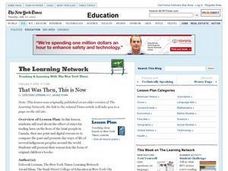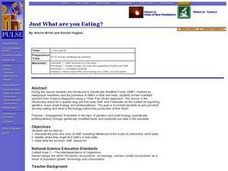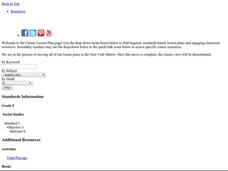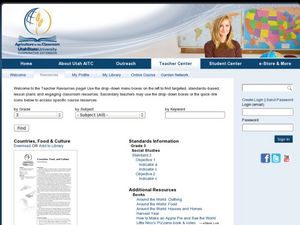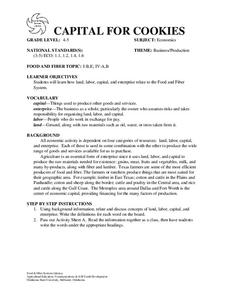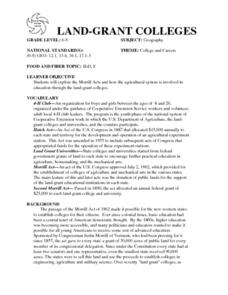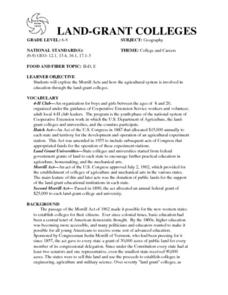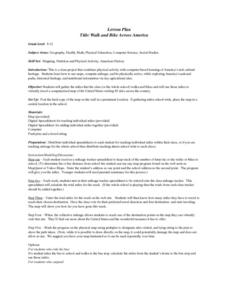Curated OER
That Was Then, This Is Now
Young scholars examine the price of food over time. They analyze charts, perform math operations and compare and contrast data about the price of food. They complete worksheets while interperting the charts.
Curated OER
Maintaining Plant Genebanks
High schoolers examine the use, costs, and the need for plant gene banks. The rationale for gaining ownership over scientific information and the implications of the developing nations' reliance on biotechnology is explored in this...
Curated OER
Next Year's Seeds
Fifth graders explore genetic traits. In this genetic traits lesson, 5th graders discover how traits are passed from parent to offspring while examining plants. Students problem solve real world applications.
Curated OER
America the Bountiful
Fifth graders explore the impact exploration and colonization of North America had on human history. In this American colonies lesson, 5th graders compare differences between colonial areas. Students investigate the global impact of...
Curated OER
Just What are you Eating?
Students identify and articulate pros and cons of genetically modified foods (GMF) including references to scale of controversy worldwide. Students then identify where they might find GMFs in their diets, read different opinion pieces on...
Curated OER
Where Does It Come From?
Fifth graders explore free trade. In this free trade instructional activity, 5th graders discover which commonly found products are made in the United States and which originate from other countries. Students explore which countries are...
Curated OER
Ireland
Second graders discuss Ireland including its politics, education system, agriculture, etc . . . They locate Ireland on a map, and list facts about the country. They compare Irish money to American money.
Curated OER
Who's Who?
Students explore biology by identifying animals and their environments. In this animal characteristic lesson, students read assigned text about farm animals, how they are raised, and what they are used for in our society. Students view a...
Curated OER
Countries, Food and Culture
Third graders explore food production by researching culinary culture on the Internet. In this global food lesson, 3rd graders read assigned text about the different dietary habits of foreign cultures based upon their environment....
Curated OER
Case of the Missing Pumpkin
Fourth graders explore holidays by participating in a pumpkin activity. In this vegetation lesson, 4th graders discuss the different uses for pumpkins, not just Halloween decorations. Students identify the nutrients pumpkins need to...
Curated OER
Pizza Time!
Fifth graders explore healthy dietary guidelines. In this dietary guidelines lesson, 5th graders investigate fractional parts of a healthy diet using pizza as a visual aid.
Curated OER
Food Systems Feed the World
Sixth graders consider the source of their nutrition. In this food systems lesson, 6th graders discuss how food gets to the table and the process it goes through. Students reflect on world hunger issues, farming, and consumerism through...
Curated OER
Capital for Cookies
Students explore how land, labor, capital, and enterprise relate to the Food and Fiber System. They write a story about a company they would open in the community, create a company to make an agricultural product and discuss the various...
Curated OER
Read All About It! California History of the 30s and 40s
Explore the Great Depression! Discover the challenges people experienced during the time period. Learners investigate photographs from the Dust Bowl and WWII era and create a story line about the photographs, writing a newspaper article...
Global Oneness Project
Citizen Photojournalism
Matt Black's photo essay, "The Geography of Poverty" provides a shocking reminder of the poverty that exists in the United States. The resource not only focuses attention on poverty but also conditions that have given rise to situation...
Curated OER
Water: From Neglect to Respect
The goal of this collection of lessons is to make middle schoolers more aware of the ways in which they are dependent upon water to maintain their standard of living. Learners compare water use in Lesotho to water use in the United...
Curated OER
India: Is Terrorism Hurting the Economy?
Students investigate the effect of terrorism on the Indian economy. They conduct research on terrorist activity in India, create a timeline, and participate in a summit between Indian and Pakistan.
Curated OER
Water Works
Students create a "water web" to illustrate the interdependence among water users and producers. They distinguish between direct and indirect uses of water; illustrate the interconnectedness of water users in a community; and demonstrate...
Global Oneness Project
Living with Less Water
Did you know that California produces two thirds of the fruits and nuts consumed in the United States? That it produces almost one third of the vegetables? Did you know that scientists warn that California is facing the onset of a...
Curated OER
LAND-GRANT COLLEGES
Students will explore the Morrill Acts and how the agricultural system is involved in education through the land-grant colleges.1. Have groups find the addresses of the land-grant universities in their assigned states and
write a letter...
Curated OER
Land Grant Colleges
Students are introduced to the concept of land grant colleges which allowed agriculture to be brought into education. As a class, they create a timeline and compare and contrast the land grant colleges of 1890 and 1892. They use maps...
Curated OER
Reflecting and Creating
Students evaluate the sustainability of an enterprise based on how well it contributes. In this sustainable agriculture lesson students build skills as they work together by using the Internet to research and develop their own...
Curated OER
Farming in a Fishbowl: How Ethnic Groups in
Seventh graders research Chinese agricultural needs and practices. They conduct an experiment with aquaculture and germinated rice as they take measurements and apply the scientific method.
Curated OER
Walk and Bike Across America
Students learn how to use maps, compute mileage, and be physically active while exploring America's national parks, historical heritage, and nutritional information via key agricultural sites.


